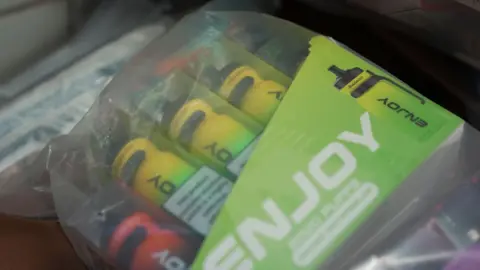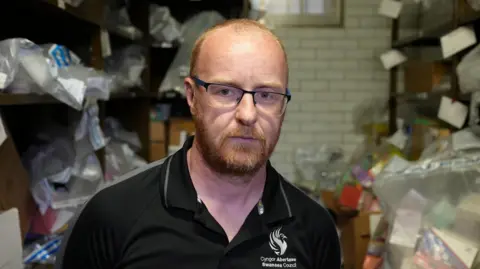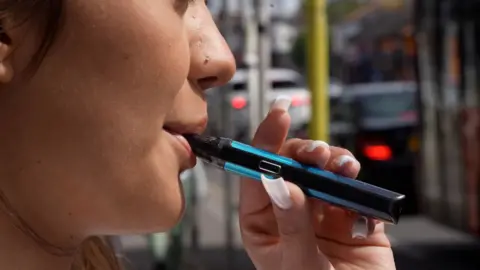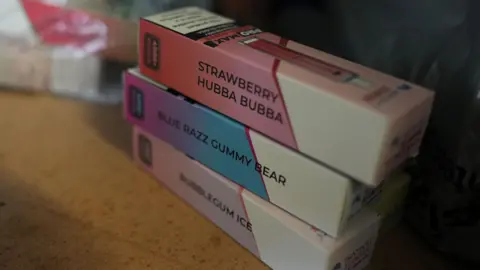 BBC
BBCIllegal vapes are being sold alongside cuddly toys and action figures in toy shops, trading standards has said.
Over the past few months, the authority in Swansea said it had seized more than 140,000 illegal vapes.
A new survey by Action on Smoking and Health Wales (Ash) found more than half of secondary school pupils who vaped were likely to be using illegal products, which bypass UK regulations and can contain significantly higher levels of nicotine.
The Welsh government said it was “very concerned about the worrying rise in vaping among children” and was working with the UK government to tackle the problem.
“Now there are vapes ripping off the Prime drinks brand – if that’s not targeting kids then what is,” said Swansea Trading Standards officer Rhys Harries.
“When we send kids in to [vaping stores] they come out with the illegal vapes, that’s what’s being pushed towards them.”
Among hundreds of exhibits in Swansea’s evidence room is one shelf filled with counterfeit children’s toys.
Buried among them are cola and lime vapes with a big sticker declaring that the products are nicotine free.
A product like this can, in theory, legally be “sold to anyone” explains Mr Harries.
But when he removes the outer packaging, inside is a regular disposable vape containing 2% nicotine.

What is an illegal vape?
- In the UK, disposable vapes have to follow strict regulations – they cannot contain more than 2ml of liquid, with 20mg of nicotine contained within that – similar to 20-40 cigarettes’ worth
- Illegal vapes ignore these rules and often contain significantly higher doses of nicotine and liquid
- One of the easiest ways to spoke an illegal vape is if the “puff count” exceeds 600-800
- Trading Standards say some illegal vapes can be equivalent to smoking 20 cigarettes in one go
Mr Harries said in Swansea about two-thirds of the calls Trading Standards get from the public are now about vapes being sold to children, or illegal vapes.
“It’s a huge explosion. There’s so much profitability in these products – and that’s one of the reasons there’s such an issue,” he said.

Many of the illegal vapes being seized come from “pop-up vape stores” which appear for a few months before closing down.
Mr Harries says most are run by “serious organised crime” gangs, who have realised how lucrative the market is.
There are concerns that the higher unregulated nicotine levels in illegal vapes could increase addiction levels.
A survey of more than 12,000 secondary school children in Wales, which Ash Wales said was the largest of its kind in the UK, suggested 45% of those who vaped couldn’t get through the school day without it.
“It shows a level of addiction that we didn’t know existed,” said Ash’s Suzanne Cass.
“Anecdotally, we knew from teachers and educators that young people were struggling to not vape during the school day, but we didn’t have the evidence. Now we’ve got the evidence.
“Young people have told us that, actually, it’s quite easy to get hold of these products – and these are young children, from as young as 11 years old.”

Figures suggest the number of children who vape is increasing, but still in the minority.
The Ash report found 7% of children across secondary school reported regularly vaping, but there are concerns about the level of addiction among those who do.
Wales Live has heard reports of some children in schools resorting to other nicotine products like Snus to get the through the day without vaping.
The sachet, similar to a small tea bag, is placed under the lip and release nicotine into the blood stream.
Some schools said they had needed to place extra staff on duty to stop children vaping at break times, while a small number of secondary schools had installed vape detection devices in toilets.
Josh, who is 12, said he thought it was “really easy” for children to get vapes.
“Some in Year 7, some in Year 8 and older kids – loads of people do it now.
“Some corner shops sell it to them and they just don’t ask for ID or anything they just sell it to them.”

The survey also suggested teenage girls were more likely to vape than boys.
By Year 13, the survey recorded 17% of girls reporting to vape, compared to 10% of boys.
One 15-year-old girl, who did not want to be named, said she had been introduced to vaping by a friend in school when she was 13.
“I buy them from shops,” she said.
“I could go without it for a day and would then get into a massive mood. I’d like to stop.”
The Independent British Vape Trade Association said legitimate stores were working “tirelessly to ensure they supply only compliant products and carry out checks to verify the ages of their customers”.
“This intent is consistently undermined by those who are supplying illegal products, not adhering to their age verification responsibilities, or in many cases both. Either individually, or even worse, put together, these practices risk both consumer safety and the reputation of the sector,” they said.
The Welsh government said vapes should “never be used” by children or people who did not already smoke.
“We are working with the other UK governments to tackle youth vaping and reduce the appeal, availability and affordability of vapes to children through the Tobacco and Vapes Bill,” said a spokesperson.
“This Bill will enable us to regulate the flavours and contents of vapes, their packaging and where they are displayed in shops so that we can prevent them being promoted to and accessed by children. From 1 April 2025, we also plan to ban single use (disposable) vapes due to their significant environmental impact and because they are clearly linked to the recent rises in vaping in children.”

